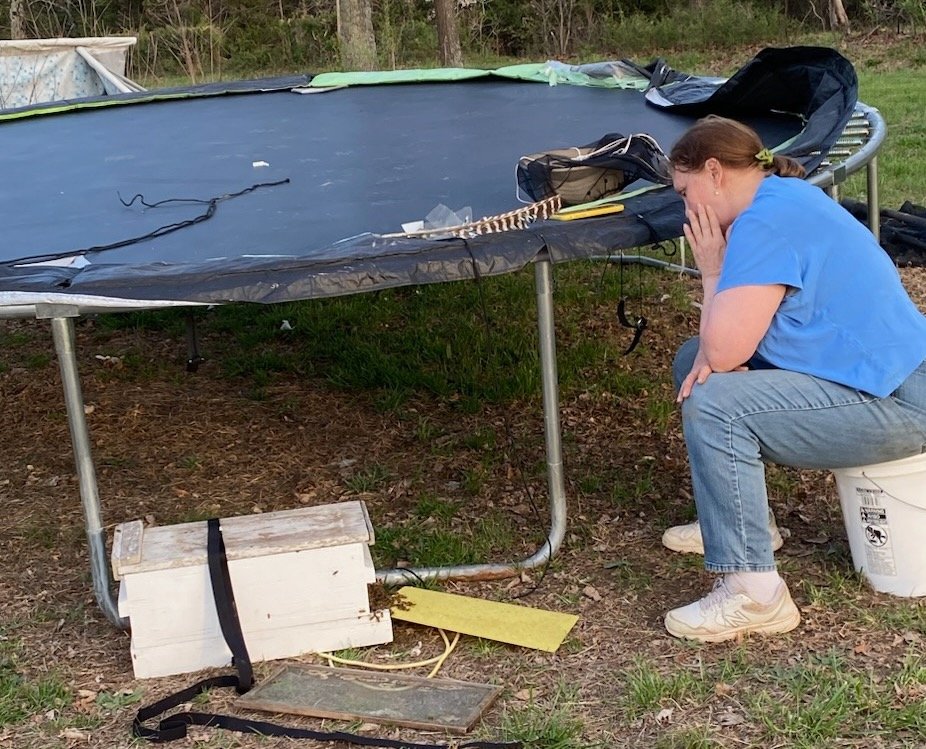Wow, White Clover!
/This island in a roundabout has a lovely crop of white clover. (Photo by Charlotte Ekker Wiggins)
Wow, White Clover!
I was driving through our northern-most roundabout a couple of days ago, in the rain, when I almost jumped the center median. Up ahead along the roundabout curve was the most beautiful sight, a traffic island covered in white clover!
After making my turn, I doubled back to get a better look, and some photos.
Of all of the plans beekeepers can plant for honey bees in the eastern part of the US, white clover would top that list. According to Sustainable Agriculture Research and Education, this low growing plant has a lot of wonderful qualities including feeding bees nectar and pollen. Nectar is a bee’s flight fuel; pollen is baby food.
White Clover Trifolium repens is also known as Dutch White, New Zealand White and Ladino. I call it an excellent cover crop and a great alternative to planting turf grass. It is a long-lived perennial that holds in soil, helps replenish soil and provides critical food to pollinators including bees.
There are other ways to use white clover in a garden and landscape. White clovers are a top choice for “living mulch” systems planted between rows of irrigated vegetables, fruit bushes or trees. They are persistent, widely adapted perennial nitrogen producers with tough stems and a dense shallow root mass that protects soil from erosion and suppresses weeds. Depending on the type, plants grow just 6 to 12 inches tall, but thrive when mowed or grazed.
Once established, they stand up well to heavy field traffic and thrive under cool, moist conditions and shade.
Cultivars of white clover are grouped into three types by size. The lowest growing type (Wild White) best survives heavy traffic and grazing. Intermediate sizes (Dutch White, New Zealand White and Louisiana S-1) flower earlier and more profusely than the larger types, are more heat-tolerant and include most of the economically important varieties. The large (Ladino) types produce the most N per acre of any white types, and are valued for forage quality, especially on poorly drained soil. They are generally less durable, but may be two to four times taller than intermediate types.
White clover performs best when it has plenty of lime, potash, calcium and phosphorus, but it tolerates poor conditions better than most clovers. Its perennial nature depends on new plants continually being formed by its creeping stolons and, if it reaches maturity, by reseeding.
White clover is raised as a winter annual in the South, where drought and diseases weaken stands. It exhibits its perennial abilities north through Hardiness Zone 4. The short and intermediate types are low biomass producers, while the large ladino types popular with graziers can produce as much biomass as any clover species.
White clover is an excellent choice for high traffic areas. (Photo by Charlotte Ekker Wiggins)
More White Clover Benefits
Wherever there’s intensive field traffic and adequate soil moisture, white clover makes a good soil covering that keeps alleyways green. It reduces compaction and dust while protecting wet soil against trauma from vehicle wheels. White clover converts vulnerable bare soil into biologically active soil with habitat for beneficial organisms above and below the soil surface.
Premier living mulch. Their ability to grow in shade, maintain a low profile, thrive when repeatedly mowed and withstand field traffic makes intermediate and even short-stemmed white clovers ideal candidates for living mulch systems. To be effective, the mulch crop must be managed so it doesn’t compete with the cash crop for light, nutrients and moisture. White clover’s persistence in the face of some herbicides and minor tillage is used to advantage in these systems (described below) for vegetables, orchards and vineyards.
Spreading soil protector. Because each white clover plant extends itself by sending out root-like stolons at ground level, the legume spreads over time to cover and protect more soil surface. Dropped leaves and clipped biomass effectively mulch stolons, encouraging new plants to take root each season. Reseeding increases the number of new plants if you allow blossoms to mature.
Over seeded companion crop. Whether frost seeded in early spring into standing grain, broadcast over vegetables in late spring or into sweet corn in early summer, white clover germinates and establishes well under the primary crop. It grows slowly while shaded as it develops its root system, then grows rapidly when it receives more light.
White clover makes a pretty border and edging. (Photo by Charlotte Ekker Wiggins)
And, it’s pretty, adding a lovely white blanket. Even before I had honey bees, I used to move white clover to spots in my garden, especially those where little would grow.
Glad to see this hardy plant getting renewed attention and use!














